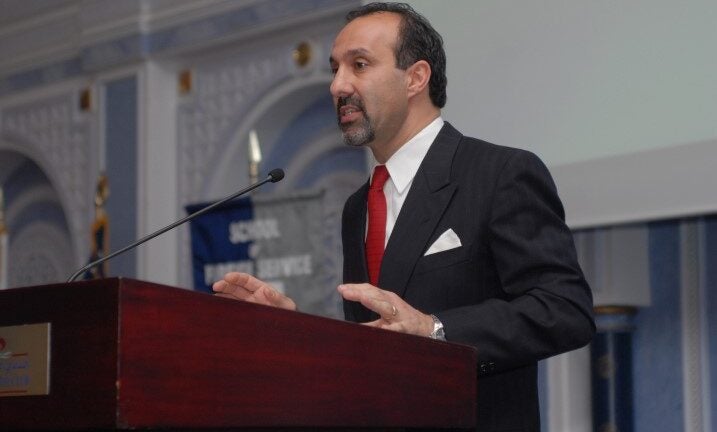American Studies, CIRS Faculty Lectures, Dialogue Series, Regional Studies
Mehran Kamrava on the United States and Iran

On September 10, 2007, Dr. Mehran Kamrava, head of the Center for International and Regional Studies housed at Georgetown’s School of Foreign Service in Qatar, spoke to an overflow crowd at the Diplomatic Club in Doha. He prefaced his talk, entitled “The United States and Iran: A Dangerous but Contained Conflict,” by noting the cloud of uncertainty hanging over the region. Compelled each morning to check whether or not war had broken out the night before, Dr. Kamrava described the current state of affairs between the United States and Iran as decidedly grim. Irreconcilable differences in foreign policy and strategic objectives appear to be propelling the two countries towards open conflict.
Painting in broad historical strokes, Dr. Kamrava outlined the guiding principles or “logics” animating American foreign policy in the Middle East, including ready access to oil, the security of the state of Israel, and the containment of threats to American interests. Iran’s own strategic ambition of being a regional superpower whose security is guaranteed by proxies operating inside of Iraq and Lebanon, as well as Tehran’s insistence on a continued nuclear program, set the stage for an intractable conflict of interests between the US and Iran.
Dr. Kamrava interlaced his analysis with a consideration of the role of leadership and personalities. He described the current American and Iranian administrations as populated by leaders whose rigid adherence to ideological precepts exacerbate an already heated situation. Dr. Kamrava noted that what was once an American foreign policy premised on a realpolitik, balance-of-power approach to the region has been replaced by what the Project for a New American Century described as a “Reaganite policy of military strength and moral clarity,” exemplified by the neo-conservative doctrine of “forward defense.” The ideals of “freedom” and “human dignity” emanating from Washington were not just slogans but the perorations of a “presidency of believers.” These ideologues found their counterparts on the Iranian side. Dr. Kamrava went so far as to describe Ahmadinejad as the “Iranian Bush.”
Nonetheless, Dr. Kamrava cautioned against reading too much into the positions of American and Iranian political leaders. Domestic pressures remain an unknown and crucial factor going forward, as both governments face growing discontent and division amongst popular as well as elite elements. In the short term, Dr. Kamrava prognosticated that uncertainty will likely continue to hang over the region. Nonetheless, he argued that certain breaks and mechanisms exist which he deemed “logics,” that could prevent the current impasse from erupting into war.
Dr. Kamrava closed by offering three possible future scenarios, the first being the continuation of an untenable status quo in which unresolved tensions and hostility between Iran and the U.S. spill over into -the second scenario,- open conflict. Dr. Kamrava emphasized that such a war would be a catastrophe for both sides. A glimmer of hope lies in the narrow path of reconciliation that runs between the first two scenarios. Returning to his earlier theme, Dr. Kamrava advocated conditional engagement through the “Baghdad track” as a way for the US and Iran to reconcile their differences.
Summary prepared by Shervin Malekzadeh. Shervin is a Teaching Assistant at the Georgetown University School of Foreign Service in Qatar.